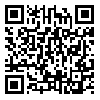Volume 81, Issue 1 (April 2023)
Tehran Univ Med J 2023, 81(1): 68-76 |
Back to browse issues page
Download citation:
BibTeX | RIS | EndNote | Medlars | ProCite | Reference Manager | RefWorks
Send citation to:



BibTeX | RIS | EndNote | Medlars | ProCite | Reference Manager | RefWorks
Send citation to:
Khazaeeshir Z, Mirzakhani K, Ahmadinezhad G S, Naderi F S, Jahani Shoorab N. Investigating the results of breastfeeding counseling in mothers referred to the breastfeeding counseling clinic of the health centers. Tehran Univ Med J 2023; 81 (1) :68-76
URL: http://tumj.tums.ac.ir/article-1-12335-en.html
URL: http://tumj.tums.ac.ir/article-1-12335-en.html
Zeinab Khazaeeshir * 
 1, Kobra Mirzakhani2
1, Kobra Mirzakhani2 
 , Golnaz Sadat Ahmadinezhad3
, Golnaz Sadat Ahmadinezhad3 
 , Fatemeh Sadat Naderi1
, Fatemeh Sadat Naderi1 
 , Nahid Jahani Shoorab2
, Nahid Jahani Shoorab2 


 1, Kobra Mirzakhani2
1, Kobra Mirzakhani2 
 , Golnaz Sadat Ahmadinezhad3
, Golnaz Sadat Ahmadinezhad3 
 , Fatemeh Sadat Naderi1
, Fatemeh Sadat Naderi1 
 , Nahid Jahani Shoorab2
, Nahid Jahani Shoorab2 

1- Department of Midwifery, School of Nursing and Midwifery, Mashhad University of Medical Sciences, Mashhad, Iran.
2- Nursing and Midwifery Care Research Center, Mashhad University of Medical Sciences, Mashhad, Iran.
3- Department of reproductive Health, School of Nursing and Midwifery, Mashhad University of Medical Sciences, Mashhad, Iran.
2- Nursing and Midwifery Care Research Center, Mashhad University of Medical Sciences, Mashhad, Iran.
3- Department of reproductive Health, School of Nursing and Midwifery, Mashhad University of Medical Sciences, Mashhad, Iran.
Abstract: (881 Views)
Background: The rate of exclusive breastfeeding in Iran at the ages of 3 and 6 months is estimated to be 44% and 27%, respectively, which is still far from the optimal index of the World Health Organization until 2030 (70% in the first six months). In order to monitor breastfeeding counseling centers, which have been set up with the aim of promoting breastfeeding and supporting mothers who have problems with breastfeeding.
Methods: This is a descriptive-retrospective study and all the mothers who were referred to the Health and Treatment Center No. 2 in Mashhad between April 2019 and March 2019 were examined. This health center has two active counseling clinics and the collection of information is based on documents registered in offices and computers. The inclusion criteria for study were not having breast diseases, having an infant child, being able to read and write and living in Mashhad city. The exclusion criteria were also the unwillingness to participate in the study and the newborn suffering from diseases that are incompatible with breastfeeding. Therefore, census sampling was done. The data were analyzed using SPSS 16 software and the significance level was less than 0.05.
Methods: This is a descriptive-retrospective study and all the mothers who were referred to the Health and Treatment Center No. 2 in Mashhad between April 2019 and March 2019 were examined. This health center has two active counseling clinics and the collection of information is based on documents registered in offices and computers. The inclusion criteria for study were not having breast diseases, having an infant child, being able to read and write and living in Mashhad city. The exclusion criteria were also the unwillingness to participate in the study and the newborn suffering from diseases that are incompatible with breastfeeding. Therefore, census sampling was done. The data were analyzed using SPSS 16 software and the significance level was less than 0.05.
|
Results: In 42.8% of cases, mothers had started feeding combined formula with breast milk before visiting, and in 28.1% of cases, when referring to counseling milk clinics, it was reported that the baby was fed only with formula. After breastfeeding consultations and follow-ups at the end of six months, the rate of exclusive breastfeeding is 34.1% (12% increase compared to the initial reference) and combined formula feeding with breastmilk is 27.8% (a 22% decrease compared to the first visit). And feeding with powdered milk alone was calculated to be 36.5% (an increase of 8.4% compared to the first visit).
Conclusion: The positive role of breastfeeding counseling center in reducing the cases of artificial feeding is clear, and it is recommended to prepare written instructions based on the challenges in breastfeeding for breastfeeding counseling in the first month after delivery. |
Type of Study: Original Article |
Subject:
Endocrinology
| Rights and permissions | |
 |
This work is licensed under a Creative Commons Attribution-NonCommercial 4.0 International License. |



